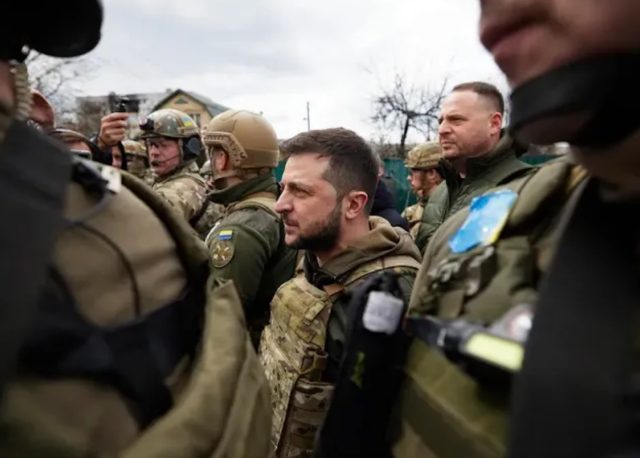As Russia’s invasion of Ukraine heads into its second year, the American-led strategy of handing off weapons to Kyiv and hoping the underdog can defeat the overdog needs adjustment. Both US Secretary of Defense Lloyd Austin and Chairman of the Joint Chiefs of Staff Mark Milley have expressed concerns about the US-German tank deal for Kyiv. But US F-16 fighter jets have been rumored as the next Ukrainian “ask.”
Supporters of the weapons-only strategy often cite Israel, usually with admiration. Israel doesn’t ask for, want, or have American forces fighting for it. With American weapons and outside support, Israel defeats its enemy and remains secure. This, they say, validates the Biden administration’s strategy.
It isn’t an exact analogy. Israel has an indigenous weapons and training capability and has spent its modern lifetime improving its ability to meet and defeat its enemies. Even so, it finds its ties, first to the US European Command (EUCOM) and now the US Central Command (USCENTCOM), a welcome source of allied cooperation. Israel isn’t asking for American troop support, but certainly sees itself as part of an integrated defense in the Red Sea and beyond.
Further, Israel’s state enemies have had battlefield doctrine, equipment, and outside political support that was manageable for Israel. Non-state actors represented challenges of a different, but not existential, nature. Iran in both its nuclear and terror-supporting modes presents a new threat and Israel’s doctrine has evolved accordingly.
Ukraine, on the other hand, faces Russia. And Russia’s military history is one of “grinding” until the enemy gives up. The number of Russians Moscow was willing to commit to battle has historically been endless, and the destruction of enemy infrastructure and civilian targets is part of the plan. Stalin’s war in Ukraine cost an estimated 3.9 million Ukrainian lives. An estimated 40,000 Soviet civilians died in a defensive battle at Stalingrad, along with 800,000 Axis troops and 1,100,000 Soviet forces killed, wounded, or captured. Overall, Russian figures show 8.6 million military casualties in WWII and 24-27 million casualties overall.
To recount the statistics is NOT to suggest abandoning Ukraine, but to put American and NATO choices in perspective. And recognize that Russia’s President Vladimir Putin has choices as well.
Stefano Sannino, secretary general of the European Union’s European External Action Service, says Russia is now at war against NATO and the West, adding that Putin has taken the war to a “different stage,” raising the specter of a global conflict. Putin, he said, will increase indiscriminate attacks on civilians and non-military targets and retaliate against the West.
America’s first choice is to decide that our goal is to “defeat Russia.” That may include adopting Ukrainian President Volodymir Zelensky’s stated goals of a) recovery of all Ukrainian territory including Crimea, b) reparations from Russia, and c) war crimes trials. It may not include all of those things, but if the plan includes expelling Russian forces, Western soldiers are likely required. The NATO Air Forces plus tanks can push Wagner troops out of southern Ukraine; a Marine assault on Crimea could dislocate the Russians. The Russians will be defeated.
Maybe.
Putin may decide that this war is too important to lose. Battlefield nuclear weapons are only one choice he has. Attacks on other non-NATO countries, or even NATO countries, could quickly dissuade Europeans from joining President Biden and Zelensky. “We didn’t sign up for a European land war,” could become the mantra. They didn’t, but they behaved as if they did, and the war may come to them whether they want it or not.
Choice number two is to announce that the allies will continue to provide weapons for the Ukrainians to use for as long as there remain Ukrainians to use them. All casualty statistics are suspect but the very range of numbers in this case is telling. In early January 13,000 military casualties were reported by the BBC, and the UN High Commission on Human recorded 17,994 civilian casualties. Gen. Milley, however, estimated 200,000 military casualties on all sides last November. “You’re looking at well over 100,000 Russian soldiers killed and wounded. Same thing probably on the Ukrainian side.”
Yes, the Russians are having trouble filling the ranks of their soldiers, but they have a wider field. At the same time, it is conceivable that even in the lower estimated range of military casualties, the Ukrainian military has lost its best trained professional soldiers early in the war. Their resources are much fewer.
The third choice is to decide that the war will end in a negotiated settlement. Again, that isn’t only a choice for the allies – it has to be agreed by Vladimir Putin. Who talks to Putin, what he/she says, and how Putin responds could set the stage for talks even if Zelensky has to be brought in as an unwilling partner. Or not.
Having more weapons and more money may not be the determining factor in America’s choices in Ukraine. And analogies are not battlefield strategies.


